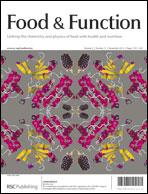The effects of food components on hormonal signalling in gastrointestinal enteroendocrine cells
Abstract
The incidence of obesity and obesity-associated diseases, such as type-2 diabetes, has reached epidemic proportions in recent years. It is predicted that by 2015 over 1.5 billion consumers will be overweight or obese. Several of the current drug-based treatments on the market for weight management and appetite control either lack efficacy or are associated with adverse side-effects. There is, therefore, an opportunity to develop functional foods which are both nutritionally beneficial but which also aid in weight management. Peptides produced in the gastrointestinal tract, which function to regulate feed intake and satiety, have been identified as key targets for bioactive ingredients in functional foods. These peptides are produced and released by specialised enteroendocrine cells. Understanding the interaction of foods with these cells is vital to the development of food matrices with positive health benefits. This review describes enteroendocrine cell populations in detail and focuses on the peptides that they produce in addition to their other functions, including taste transduction. Several food-based sources of bioactives and current food products on the market with beneficial effects on satiety and glycaemia will also be discussed.


 Please wait while we load your content...
Please wait while we load your content...